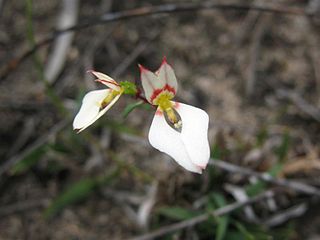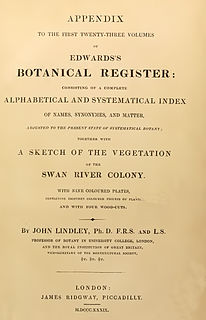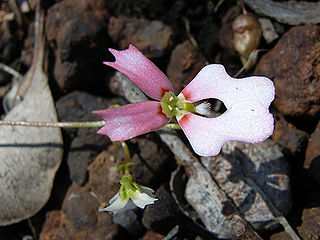
Stylidium is a genus of dicotyledonous plants that belong to the family Stylidiaceae. The genus name Stylidium is derived from the Greek στύλος or stylos, which refers to the distinctive reproductive structure that its flowers possess. Pollination is achieved through the use of the sensitive "trigger", which comprises the male and female reproductive organs fused into a floral column that snaps forward quickly in response to touch, harmlessly covering the insect in pollen. Most of the approximately 300 species are only found in Australia, making it the fifth largest genus in that country. Triggerplants are considered to be protocarnivorous or carnivorous because the glandular trichomes that cover the scape and flower can trap, kill, and digest small insects with protease enzymes produced by the plant. Recent research has raised questions as to the status of protocarnivory within Stylidium.

The family Stylidiaceae is a taxon of dicotyledonous flowering plants. It consists of five genera with over 240 species, most of which are endemic to Australia and New Zealand. Members of Stylidiaceae are typically grass-like herbs or small shrubs and can be perennials or annuals. Most species are free standing or self-supporting, though a few can be climbing or scrambling.

Banksia proteoides, commonly known as king dryandra, is a shrub endemic to Western Australia. It was known as Dryandra proteoides until 2007, when all Dryandra species were transferred to Banksia by Austin Mast and Kevin Thiele.

Andersonia is a subgenus of Stylidium that is characterized by a linear hypanthium, recurved mature capsule walls, an erect and persistent septum, and many seeds. This subgenus occurs in areas of tropical northern Australia and into Southeast Asia and was named in honour of William Anderson, the surgeon and naturalist who sailed with James Cook.

Stylidium section Alsinoida is a taxonomic rank under Stylidium subgenus Andersonia. In his 1908 monograph on the family Stylidiaceae, Johannes Mildbraed had established the subgenus Alsinoides for species related to S. alsinoides, which were morphologically similar to species of subgenus Andersonia. In 2000, A.R. Bean published a taxonomic revision of subgenus Andersonia and reduced subgenus Alsinoides to sectional rank, renamed Alsinoida.
Stylidium androsaceum is an invalid species name that can refer to:

Stylidium section Debilia is a taxonomic rank under Stylidium subgenus Tolypangium. In his 1908 monograph on the family Stylidiaceae, Johannes Mildbraed had established this section as Debiles. In 1999, A.R. Bean published a taxonomic revision of several sections in subgenus Tolypangium in which he renamed the section from Debiles to Debilia.

Levenhookia, also known as the styleworts, is a genus of ten recognized species in the family Stylidiaceae and is endemic to Australia. The genus is restricted to Western Australia almost exclusively with a few exceptions: L. pusilla's range extends into South Australia, L. dubia's range extends through South Australia into Victoria and New South Wales, L. sonderi is native only to Victoria, and L. chippendalei is also found in the Northern Territory.

Levenhookia stipitata, the common stylewort, is a dicotyledonous plant that belongs to the genus Levenhookia. It is an ephemeral annual that grows about 7–10 centimetres (2.8–3.9 in) tall with oblanceolate to linear leaves. Flowers are pink and bloom from August to January in its native range. L. stipitata is endemic to southwestern Western Australia where it grows in granitic or lateritic soils. This species was first described by George Bentham in 1837 as Stylidium stipitatum and was later reclassified into the genus Coleostylis, which was placed into synonymy with the genus Levenhookia.
Conospermum glumaceum, commonly known as hooded smokebush, is a shrub endemic to Western Australia.

Conospermum incurvum, commonly known as plume smokebush, is a shrub endemic to Western Australia.

Stirlingia simplex is a plant endemic to Western Australia.

"A Sketch of the Vegetation of the Swan River Colony", also known by its standard botanical abbreviation Sketch Veg. Swan R., is an 1839 article by John Lindley on the flora of the Swan River Colony. Nearly 300 new species were published in it, many of which are still current.
Stylidium aceratum is a dicotyledonous plant that belongs to the genus Stylidium. It occurs within the south west region of Western Australia

Stylidium calcaratum, the book triggerplant, is a dicotyledonous plant that belongs to the genus Stylidium. It is an ephemeral annual that grows from 5 to 10 cm tall but can grow larger at 20–30 cm tall in damp forest or scrub habitat. The few ovate leaves produced by this plant form basal rosettes around the stem. The leaves are around 3–5 mm long on short petioles. The scapes are 2–30 cm tall and produce single flowers in smaller plants and up to nine flowers in larger, more robust plants. Flowers are pink or white with red spots or lines at the individual petal bases. The petals are vertically paired and will fold over to meet each other at night or in adverse weather conditions. S. calcaratum is endemic to Australia and has a distribution that ranges from Victoria through South Australia and into Western Australia. Its habitat is recorded as being wet flats or near creeks and seepages. Pollination is achieved by a grey fly, Comptosia cuneata.
Stylidium ceratophorum is a dicotyledonous plant that belongs to the genus Stylidium. It is an annual plant that is endemic to the Kimberley region of Western Australia and northern parts of the Northern Territory. It attains a height of 12–30 cm with a basal rosette of small leaves. The leaves are petiolate, obovate, or lanceolate and are only 0.2–1 cm long. Solitary scapes are produced that bear golden yellow or orange flowers, 7–9 mm across. Its habitat has been reported as being sandy soils on creek margins in the presence of Stylidium rubriscapum and Stylidium diceratum or in river paperbark stands. S. ceratophorum appears similar to S. diceratum and may be confused with the species since they both have orange flowers. S. ceratophorum's corolla is twice as large as S. diceratum, though, as well as the deeply divided posterior corolla lobes of S. ceratophorum.
Stylidium diceratum is a dicotyledonous plant that belongs to the genus Stylidium. The specific epithet diceratum is Greek for "two horns", referring to the two appendages that are present on the bend of the gynostemium. It is an annual plant that grows from 15 to 35 cm tall. The longer leaves are lanceolate and the shorter ones are spathulate, forming a basal rosettes around the stem. The leaves are around 5–8 mm long and 0.2-2.5 mm wide. Inflorescences are around 6–15 cm long and produce flowers that are orange with dark orange and pink veins and bloom from June to August in their native range. S. diceratum is only known from the type location, which is at creek crossings on the road to Beverley Springs in the Kimberley region of Western Australia. Its habitat is recorded as being sandy soils on creek margins. It grows in the presence of S. ceratophorum, S. rubriscapum, Drosera caduca, D. paradoxa, Byblis liniflora, and Grevillea pteridifolia. S. diceratum is most closely related to S. longicornu, but it can be confused with S. ceratophorum, which also has an orange corolla but twice as large.

Stylidium ecorne is a dicotyledonous plant that belongs to the genus Stylidium. It is an annual plant that grows from 5 to 12 cm tall. It has pale or bright pink flowers and occurs in swampy areas.
Stylidium edentatum is a dicotyledonous plant that belongs to the genus Stylidium. It is an annual plant that grows around 6 cm tall. The elliptical leaves form a basal rosettes around the stem. The leaves are around 0.3-0.8 mm long with recurved margins. Inflorescences are produced on solitary scapes and bear flowers that are white with rose-coloured markings at the base of the corolla lobes and two tooth-shaped throat appendages present. S. edentatum was a previously overlooked species that is related to and appears similar to S. calcaratum and S. ecorne. Allen Lowrie and Sherwin Carlquist described this species in 1989 and argued that if S. ecorne is considered distinct from S. calcaratum, then certainly S. edentatum warrants placement at the species level. It differs from S. calcaratum and S. ecorne by the long petioles on its recurved leaves, and the cuneate, obtuse, and unlobed posterior corolla lobes. They also have a distinctive lateral toothlike appendage at the base of each posterior corolla lobe. S. edentatum is endemic to southwestern Western Australia.
Stylidium weeliwolli is a dicotyledonous plant that belongs to the genus Stylidium. It occurs in the North West of Western Australia













